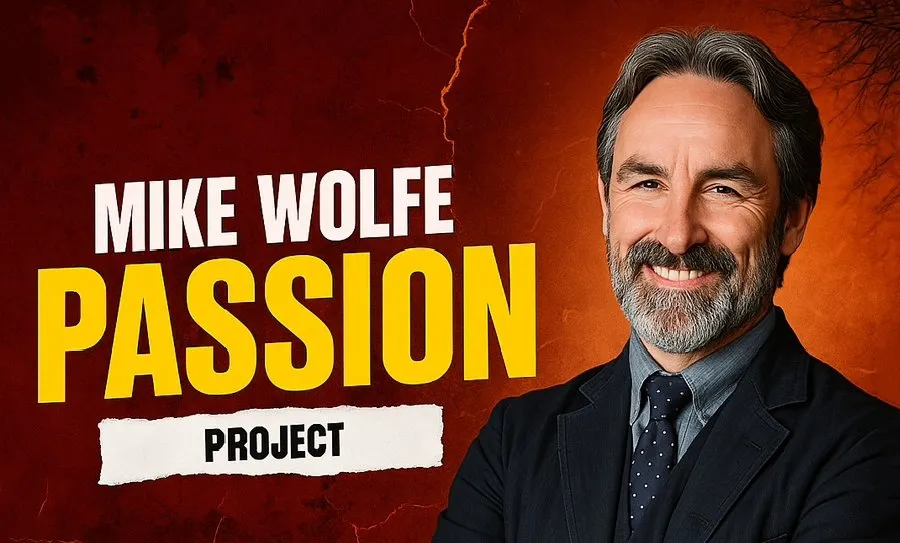Introduction: Mike Wolfe Passion Project
If you only know Mike Wolfe from American Pickers, you’re only seeing half the story. The rust, the barns, the roadside signs—those are the things that first caught his eye. But in 2025, Mike Wolfe is far more than a picker. His “passion project” is a full-blown mission: saving forgotten Main Streets, reviving historic structures, uplifting maker culture, and telling the stories behind America’s aging Americana.
Mike Wolfe’s passion project isn’t a side gig—it’s a slow burn revival that fans, townsfolk, and history lovers are rallying behind. Let’s ride shotgun through how this all came to be, what it looks like now, why it matters, and how it intersects with the work of other celebs like Joshua Jackson in maintaining legacy beyond fame.
Table of Contents
How Mike Wolfe Went From Picker to Preservationist
Mike Wolfe’s roots in antique collecting go deep. As a kid in Bettendorf, Iowa, he pedaled his bike down two-lane highways scanning garage sales, barns, and flea markets—not for profit so much as for stories. American Pickers turned that passion into a job, making him famous for uncovering forgotten relics. But gradually, those relics weren’t enough. He began seeing the places behind the relics—the buildings, the storefronts, the towns—and realized those were the real stories at risk.
The “passion project” emerged from that shift: from collecting items to preserving context. It’s the belief that when you lose the place, the story dies—even if the object survives.
What Exactly Is Mike Wolfe’s Passion Project in 2025?
In concrete terms, the project operates on several levels:
- Historic Building Restoration: Buying up and breathing new life into old buildings—storefronts, factories, industrial strips.
- Two Lanes Platform: A storytelling, travel, and online shop hub where Wolfe (and sometimes collaborators) document architecture, roadside Americana, makers, artisans.
- Heritage Craft Grants: Modest funding to help local craftspeople—blacksmiths, sign painters, furniture makers, leatherworkers—keep traditional skills alive.
- Community-Centered Spaces: Turning restored buildings into gathering places, co-working studios, shops that double as museums, or spots for small-town culture to bloom.
- Economic & Cultural Revitalization: Using preservation as a tool to revive local economies, generate tourism, drive community pride.
Key Projects You Should Know
Here are some of the flagship efforts in Wolfe’s portfolio:
| Project | Location | What He Did | Why It Matters |
|---|---|---|---|
| Columbia Motor Alley | Columbia, Tennessee | Bought an industrial strip, converted it into a mixed-use space: shops, studios, marketplaces | It acts as a cultural anchor, showing how adaptive reuse can reinvigorate downtowns. brandtspc.com+1 |
| Antique Archaeology in LeClaire, Iowa | LeClaire, Iowa | Rehabbed historic 1880s storefronts; made a flagship store + community workshop | Ground zero for Wolfe’s Americana brand, preserving hometown roots. brandtspc.com+1 |
| Nashville / Franklin, Tennessee | Tennessee | Restorations of historic homes, printshops, old commercial buildings, preserving architectural features (tin ceilings, beadboard walls) | Mix of private restorations + public benefit; preserving craftsmanship. brandtspc.com+2Kerchiller+2 |
These aren’t just photo ops—they’re long term investments in place, culture, and history.
Two Lanes: Wolfe’s Storytelling & Lifestyle Brand
If Mike Wolfe’s buildings are the physical backbone of the project, Two Lanes is its emotional spine.
- A blog / travelogue exploring backroads: spotting roadside signs, old motels, barns, neon signs, working shops.
- A curated online shop: items from local artisans, merch inspired by vintage typography and Americana imagery (think enamel mugs, leather goods, repurposed industrial design).
- A cultural archive: pictures, interviews, short essays, preservation tips. It’s where Wolfe can dive deeper than a 45-minute TV episode.
- Community engagement: fans share photos of local relics, nominate structures at risk, or even volunteer.
Two Lanes bridges Wolfe’s public persona from picker to caretaker, inviting followers to think in terms of being guardians of history, not just treasure hunters.
Supporting the Makers: Craft, Heritage, & Grants
Wolfe’s passion project extends beyond bricks and mortar—it’s about people who build, restore, make, preserve.
- Micro-grants are part of the model. Small sums ($2,000-$10,000) distributed to artisans, craftspeople, sign painters, neon benders, metalworkers. It’s not about huge profit—it’s about keeping traditional skills alive. brandtspc.com+1
- Workshops and public events: sometimes the restored spaces host events where locals can learn trade skills, restoration techniques, or just appreciate the work of artisans.
- Collaboration with local historical societies, preservation experts, and municipalities to ensure authentic restorations.
The result is not just preserved artifacts, but preserved human craft, which in many towns is at risk of disappearing.
The Economic & Cultural Impact: Why It Matters Now More Than Ever
Why are people paying attention to this? Because the impact is measurable and meaningful:
- Historic preservation has been shown to deliver strong economic returns. For example, restoring old buildings often generates more jobs per dollar than new construction. In places Wolfe is involved, historic districts draw tourists who spend in local businesses, stay in lodging, eat in local restaurants. xptmagazine.com+1
- Reviving Main Street brings commerce back to town, making downtowns active again—not just ghost strips.
- Culture & identity: in many small towns, heritage buildings are the visual and emotional markers of identity. Losing them erases stories. Wolfe’s work helps people feel rooted.
- Sustainability: restoring rather than tearing down is inherently more resource-efficient, more respectful of history and of the environment.
- Social cohesion: restored hubs become places for communities to gather, events to happen, and for generations to connect.
Challenges & Controversies
It’s not always smooth:
- Preservation vs. Gentrification: Some locals worry restorations (especially high-profile ones) will raise property values, push out longtime residents, make towns less “authentic.”
- Financial Risk: Historic buildings cost more to repair; materials must match original; labor is specialized. Many restorations go over budget.
- Regulatory hurdles: Zoning laws, historic designation requirements, local approvals can slow or complicate projects.
- Sustainability of interest: Keeping people engaged over time, beyond the novelty of “before-and-after” shots, is hard.
Mike Wolfe evidently is aware of these, and in many projects is trying to balance growth with authenticity.
How Fans & Communities Can Plug In
The passion project holds room for others—not just Wolfe himself. Here’s how you or towns you care about can engage:
- Explore “Two Lanes” — read the stories, follow the blog, discover artisans.
- Nominate Buildings or Makers — some projects allow community nominations of structures at risk or artisans who need support.
- Volunteer Locally — restoration workshops, clean-ups, fundraising.
- Buy from Small Makers — purchase goods from artisans featured in Wolfe’s shops or social media.
- Spread the Word — share stories, photos of your own town’s heritage, raise awareness.
Mike Wolfe’s Net Worth & Financial Footprint
While the passion project isn’t about maximizing profit, Wolfe has substantial resources:
- Earnings from American Pickers remain a foundation.
- Antique Archaeology stores, Two Lanes merch, events, restoration projects contribute additional income.
- Real estate investments in Tennessee (Columbia, Nashville), Iowa (LeClaire), etc. Some restored buildings are income-producing (shops, studios, markets).
Estimates vary, but his financial footprint is tied closely to preservation: instead of flipping for quick gain, many properties are meant for public use or mixed use.
What’s Next for the Mike Wolfe Passion Project in 2025 and Beyond
Here’s what appears to be coming (or plausible) as of 2025 based on trends and public commentary:
- Expansion of the “100 Buildings, 100 Stories” campaign: aiming to restore significant structures in many states by 2027.
- More documentaries, short-form content, or mini-series focused on town revitalization, not just picking items.
- Greater involvement in heritage tourism: turning restored downtowns into destinations.
- More robust grant programs and partnerships with preservation nonprofits, museums, historical societies.
- Possibly greater digital archive work: high-quality photography, storytelling, maybe even virtual tours of restored buildings or preservation processes.
FAQs About Mike Wolfe’s Passion Project
1. What exactly is Mike Wolfe’s passion project?
It’s a multifaceted mission involving restoring historic buildings, preserving craftsmanship, backing small craftsmen and makers, storytelling through Two Lanes, and helping revitalize small towns across America.
2. Where are his major restoration sites?
Columbia, Tennessee (Motor Alley and other downtown properties), LeClaire, Iowa (home base for Antique Archaeology), Nashville/Franklin, Tennessee.
3. How can someone support or participate?
Through buying from featured makers, donating or volunteering in local restoration efforts, submitting nominations or stories of buildings at risk, attending or supporting community events in restored spaces.
4. Does preservation really help local economies?
Yes. Data suggests historic restoration often creates more jobs than new construction and draws heritage tourists who spend in local businesses.
5. Is this just about nostalgia?
No. While nostalgia is part of it, the work involves serious community revitalization, sustainable development, economic benefits, preserving human craft, and giving identity to places at risk of being forgotten.
Mike Wolfe & Joshua Jackson: Different Paths, Shared Values
One reason Wolfe’s work resonates is that it echoes something we see in many celebrity profiles: the desire to build more than just fame. Take Joshua Jackson, for example. His long career, starting from Dawson’s Creek through Fringe and Dr. Death, has shown that celebrity can be steady, layered, and evolving. In much the same way that Joshua Jackson has maintained relevance by growing his roles, personal life, and public persona over decades (see Joshua Jackson’s profile on this site), Mike Wolfe is transforming his public role from picker to preservationist.
Both men show that longevity in the public eye often comes from authenticity, reinvention, and caring about something beyond just one’s own brand. Where Joshua Jackson’s fans are curious about his career, family, and net worth, Wolfe’s followers are drawn to what he does with his influence: saving buildings, telling stories, supporting makers, and lifting up communities.
Conclusion: Why Mike Wolfe’s Passion Project Matters
Mike Wolfe’s passion project gives more than restored buildings; it gives community, heritage, identity, and future. When he fixes up a storefront, patches up a tin ceiling, or supports a sign painter in small-town America, he’s preserving something many of us forget: that places tell stories, and those stories matter.
In 2025, Wolfe’s work is proof that preservation can be forward-looking—not just looking back. It shows how restoring something old can provide meaning, jobs, gathering spaces, and beauty in a world that moves fast.
If you care about history, Americana, small-town culture, or just things with character, Wolfe’s project is one to watch, support, and maybe be part of.
Internal Link
- For another celebrity whose longevity and career evolution mirror a value-driven public life, see my deep dive into Joshua Jackson: Joshua Jackson: Age, Career, Relationships, Net Worth & What’s Next in 2025

 Lizzo Weight Loss: The Real Story Behind Her Journey in 2025
Lizzo Weight Loss: The Real Story Behind Her Journey in 2025  Joshua Jackson: Age, Career, Relationships, Net Worth & What He’s Doing in 2025
Joshua Jackson: Age, Career, Relationships, Net Worth & What He’s Doing in 2025  Natalie Nunn: Age, Husband, Net Worth, and Reality TV Journey in 2025
Natalie Nunn: Age, Husband, Net Worth, and Reality TV Journey in 2025  Megan Moroney Age: How Old Is She Really and What Fans Should Know in 2025
Megan Moroney Age: How Old Is She Really and What Fans Should Know in 2025  How Much Is Justin Bieber Worth in 2025? Net Worth Revealed with Shocking Details
How Much Is Justin Bieber Worth in 2025? Net Worth Revealed with Shocking Details  How Much Is Taylor Swift Worth in 2025? Net Worth Revealed with Shocking Details
How Much Is Taylor Swift Worth in 2025? Net Worth Revealed with Shocking Details